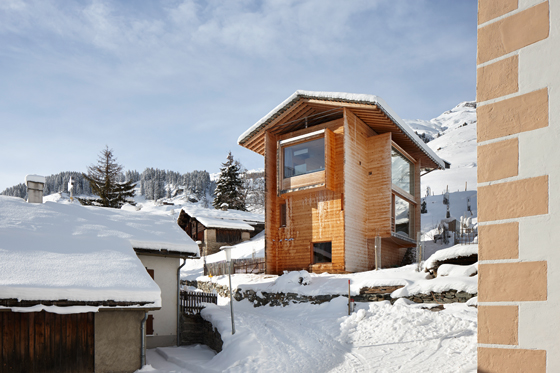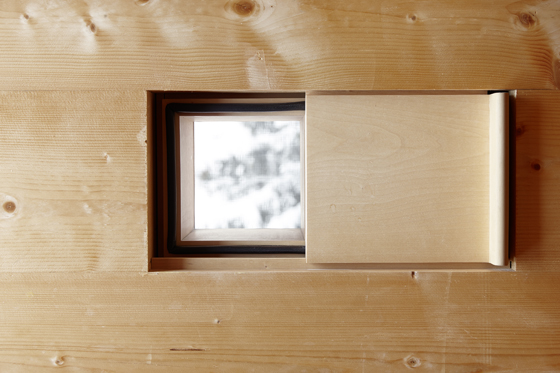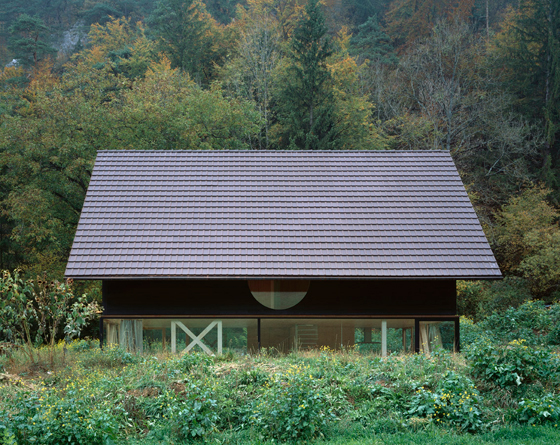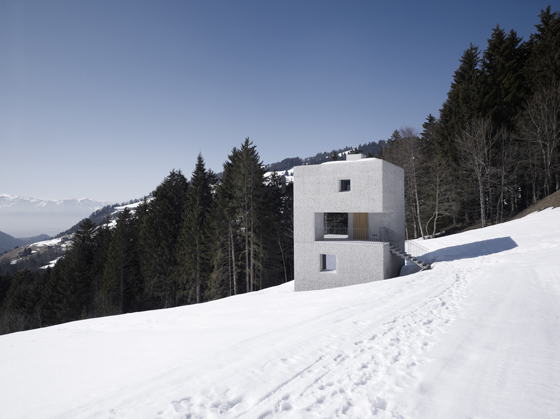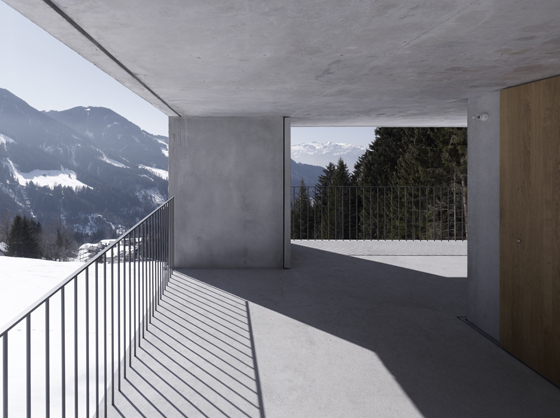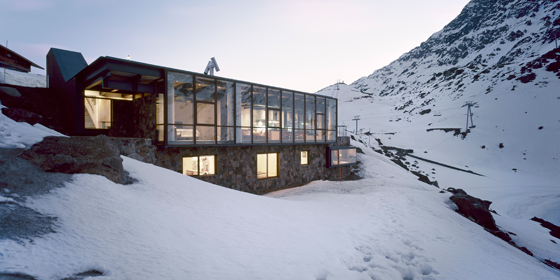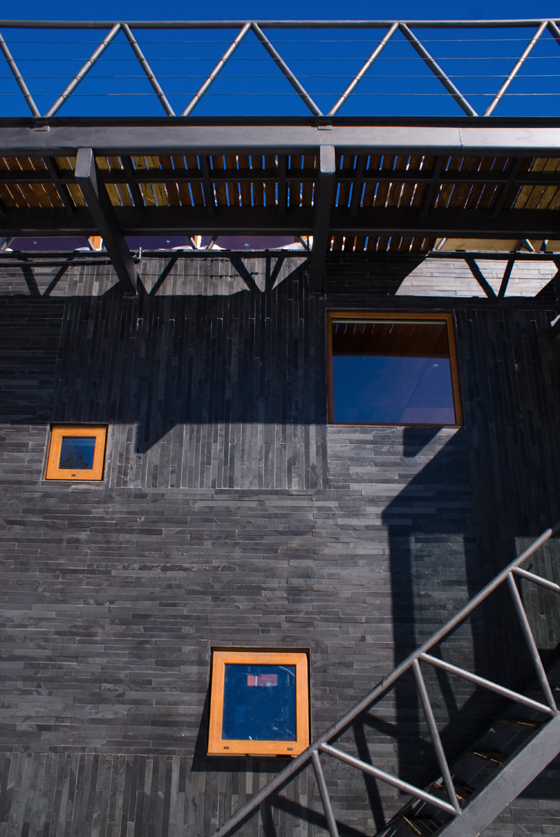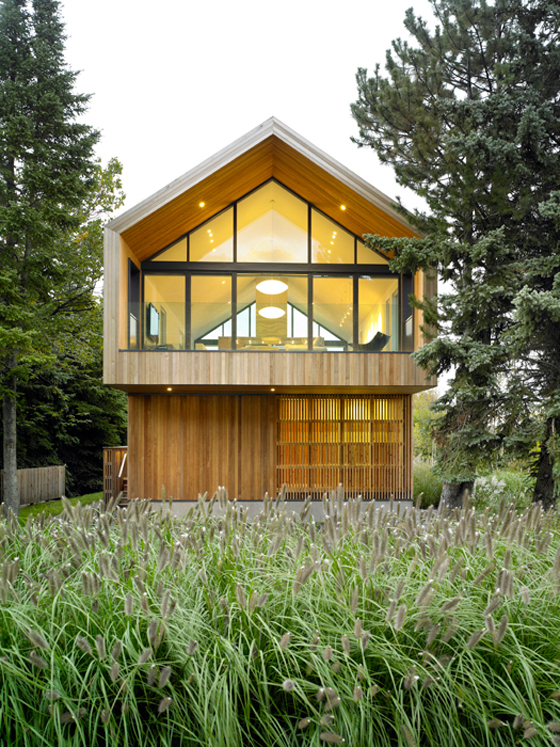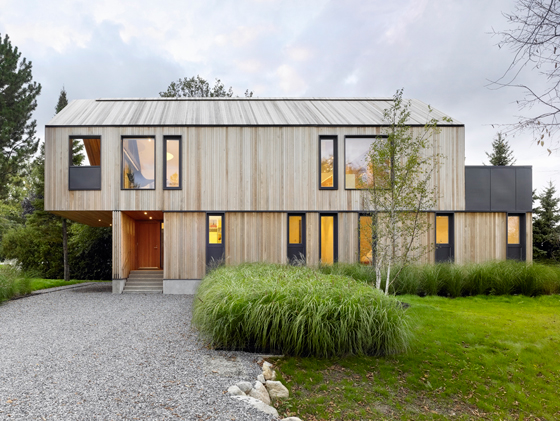Beyond the Cliché: the mountain chalet reinterpreted
Scritto da Sophie Loschert
Berlin, Germania
18.11.13
The mountain chalet has always been closely linked with the dream of a simple, rustic home in pristine natural surroundings. However, a number of projects throughout the world show that a holiday home in the mountains does not necessarily need to conform to the romantic picture of 'Gemütlichkeit' and accordingly to an outdated stereotype of the log cabin with a projecting pitched roof.
Old and new in perfect harmony: Peter Zumthor's light-coloured vacation homes in Leis, Switzerland, contrast with the weathered structures around them, but share the same construction technique; photo Ralph Feiner
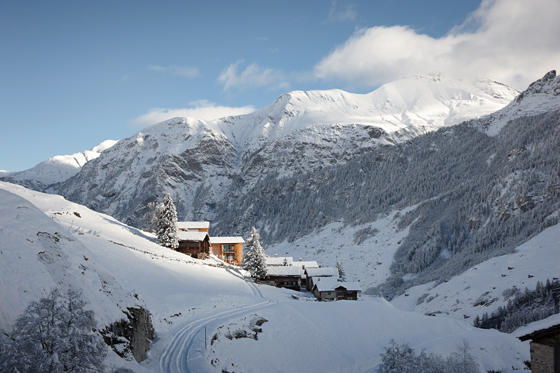
Old and new in perfect harmony: Peter Zumthor's light-coloured vacation homes in Leis, Switzerland, contrast with the weathered structures around them, but share the same construction technique; photo Ralph Feiner
×The word 'chalet' originally came from Romandy, the French-speaking region of Switzerland, and means something like 'protected location'. In fact, on the drawing board, it was the Alpine huts that cowherds used as a temporary shelter during the summer months that provided the model for this type of construction.
The spread of these log-built dwellings throughout the Alps and, from there, right round the world took place parallel to the development of Alpine tourism in the 19th century, during which the 'Swiss house' came to represent authenticity and a rural idyll. It quickly developed from a refuge for early winter sport enthusiasts into the archetypal holiday home.
However, the industrial prefabrication of individual sections and conservative building regulations subsequently led to an increasing uniformity of style. And with the construction of 'jumbo chalets' in popular holiday resorts, the log-built dwelling lost any connection with its modest predecessor and justifiably came to be regarded as kitsch.
Peter Zumthor demonstrates that the chalets of today can pick up on traditional building methods without any trace of sentimentality. He and his wife have fulfilled a highly personal dream in the form of two wooden houses in Leis, the highest settlement in the Vals region and not far from the well-known spa. Peter Zumthor writes: 'Annalisa had always dreamt of living in a wooden house and when she told me about this I had a vision of an intimate home in the mountains.'
The rooms in Peter Zumthor's wooden holiday homes in Leis are structured as block-like units. Full-height windows offer generous views out into Alpine landscape of the sparsely populated Vals valley; photos Ralph Feiner
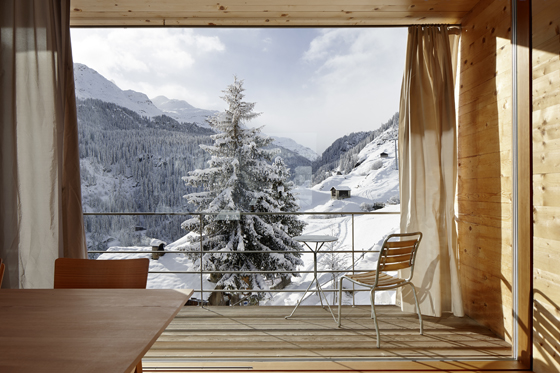
The rooms in Peter Zumthor's wooden holiday homes in Leis are structured as block-like units. Full-height windows offer generous views out into Alpine landscape of the sparsely populated Vals valley; photos Ralph Feiner
×However, the result was not just one wooden house, because, in addition to the 150 m2 Unterhus which was completed in 2009, Peter Zumthor is constructing a smaller 'sister dwelling', the 128 m2 Türmlihus, which will be finished at the end of 2013.
Zumthor's shiny new buildings don't just share their materials with the weather-worn log buildings of the region that have turned black with age. They also share the principle on which they were constructed, because Zumthor has converted every section of wood which forms the living space of the simple farmhouse into differently sized units to create individual rooms with a flexible layout.
This also enables floor-to-ceiling windows, which open up on a spectacular view of the mountain landscape. The skilful arrangement of the individual rooms provides a wide range of views of the valley.
Pascal Flammer, too, combines typical regional styles with a modern formal idiom. His Stöckli in Balsthal represents a remarkable new interpretation of traditional architectural designs. Originally the 'Stöckli' was a small building forming part of a farm in which the retired farmer would live after handing over the management of the business to the next generation.
Architect Pascal Flammer reinterpreted the region's construction style for this house in Balsthal, Switzerland, made of fir wood. Extensive glazing provides a continuous visual flow between inside and out; photos Ioana Marinescu

Architect Pascal Flammer reinterpreted the region's construction style for this house in Balsthal, Switzerland, made of fir wood. Extensive glazing provides a continuous visual flow between inside and out; photos Ioana Marinescu
×The terms of his contract restricted Flammer to strict specifications, which stipulated that the building should harmonise with both the landscape and its architectural surroundings. The house was completed in 2011 and, with its steep roof and dark facades, from a distance seems to correspond to the typical buildings of the region. However, a closer looks reveals its special character.
The ground floor, an open-plan 80 m² room without supports, has been sunk to a depth of 75 cm into the ground and is surrounded by ribbon windows stretching from the surrounding base frame, which like the entire building is made of fir, to the ceiling, giving the impression that one is in the middle of the surrounding meadow. There could be no more imperceptible transition between interior and exterior.
A winding staircase leads to the upper floor, which is divided by two intersecting walls into four equally sized rooms connected by sliding doors. The floor-to-ceiling windows at the front and rear of the building provide a view of the landscape from a raised perspective.
Meanwhile, Marte. Marte Architekten interpret the traditional holiday house in an entirely personal way. They designate their house in Laternsertal in Voralberg, which was completed in 2011 with a floor area of 102.6 m2, as a 'mountain shelter' (Schutzhütte) in reference to one of the main purposes of the chalet.
Marte.Marte Architekten's holiday home in Laternsertal, Austria, is far removed from the chalet cliché. The concrete construction does, however, speak of the traditional notion of protection; photos Marc Lins Photography
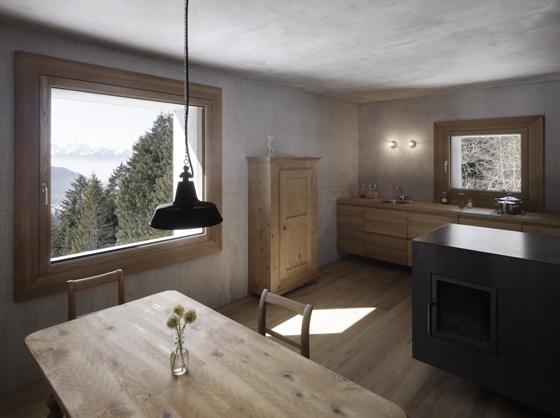
Marte.Marte Architekten's holiday home in Laternsertal, Austria, is far removed from the chalet cliché. The concrete construction does, however, speak of the traditional notion of protection; photos Marc Lins Photography
×However, in terms of form and materials, they take new directions, deliberately opting for concrete in order achieve the abstract, sculptural form of the building and its complex interplay of interior and exterior space. This is taken to extremes in the design of an open area which is enclosed within the volume of the building as negative space and breaks up the uniformity of the structure. The two supporting columns at either end of this open space, which functions as a terrace, act as a frame for the panoramic view of the landscape.
The ambivalence between what is open and what is closed in relation to the design can be seen from far off. From a distance the building seems to be hermetically closed to its surroundings, like massive rock reclining against a mountain slope. The impression of stone was created by treating the concrete walls with a hydraulic hammer. As a result, the house creates a real feeling of reassurance and protection against snow and cold. From the interior, the variously sized, large square windows and the integrated viewing platform offer a spectacular view of the mountains on the other side of the valley.
If we take a look at North and South America, we will see that fascinating reinterpretations of the mountain chalet are to be found here, too. In the spectacular surroundings of the Chilean Andes, close to the winter sports resort of Portillo, Chalet C7 created by Max Núñez and Nicolás del Rio (DRN Architects) lies at a height of 2990 m. It clings to the steep southern slope of the Inca lagoon and cannot be seen from the hotel located above it, merging discreetly into its rugged surroundings.
DRN Architects' Chalet C7 is located 3,000 metres above sea level in the Chilean Andes and merges discreetly into its surroundings. Generous fenestration makes for stunning views; photos Erieta Attali (top), Felipe Camus (above)
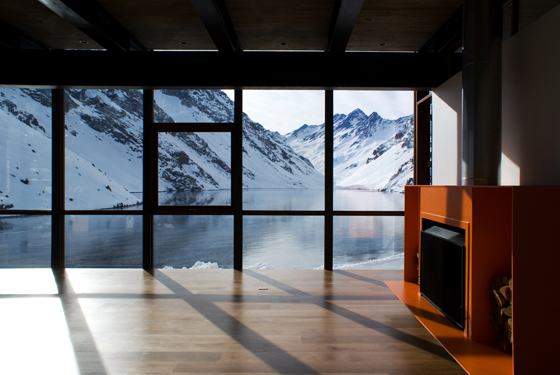
DRN Architects' Chalet C7 is located 3,000 metres above sea level in the Chilean Andes and merges discreetly into its surroundings. Generous fenestration makes for stunning views; photos Erieta Attali (top), Felipe Camus (above)
×The chalet consists of two levels, a stone-built lower floor topped by a lighter framework of steel and glass. The lower mass of stone anchors the building within the rocky slope while protecting the occupants of the building from the elements. In contrast, the upper floor is designed as a single open space in which the living area, kitchen and terrace merge into each other. The north-facing window area offers a fantastic view of the lake and the Tres Hermanos mountains.
Because of the immense volumes of snow which can pile up on the roof to a height of 6 metres, the steel framework of the upper floor has to be able to resist unusually heavy loads. This function of the beams and columns is deliberately made visible in the interior of the building, in that in addition to dividing up the open space their massive presence is an indication of the enormous weight of snow that they are capable of bearing.
A further project in Chile by DRN Architects, completed in 2008, is the Refugio Los Canteros, a multiple dwelling unit that serves both as a protective space and a platform providing a view of the Farellones mountains. With this building, too, they opted for a cube form, but ingeniously broken down into different elements, with stairways and glass enclosures projecting out beyond one another. Small windows offer a view of specific parts of the landscape, while in contrast the glass–walled rooms open up a full panorama.
DRN Architects have furnished the cube-like form of Refugio Los Canteros in Chile with playful elements – like the stairs and glass boxes that allow uninterrupted views of the panorama; photo Felipe Camus
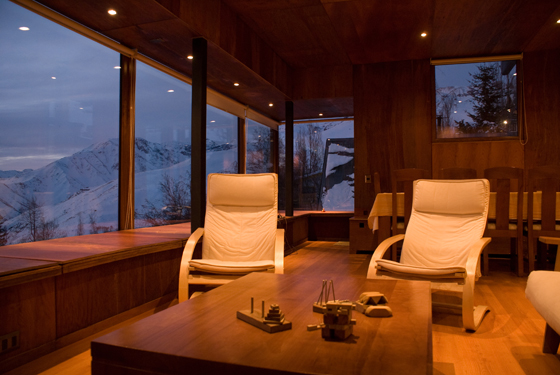
DRN Architects have furnished the cube-like form of Refugio Los Canteros in Chile with playful elements – like the stairs and glass boxes that allow uninterrupted views of the panorama; photo Felipe Camus
×In their design for Maison Glissade in Collingwood, Ontario, Canadian office Atelier Kastelic Buffey (AKB) also took their inspiration from functional agricultural buildings, in this case the North American barn.
Designed for a family of winter-sports lovers, the two-storey weekend house is located on the edge of a ski slope. Its name is not just a reference to the shared enthusiasm of the family for sliding on snow but also explains the key to its design.
The upper floor extends beyond the longitudinal axis of the ground floor to create a strong cantilever at one end and a wide platform at the other end of the house. The latter can be accessed from the upper floor and is used as a balcony.
Maison Glissade in Collingwood, Ontario, lies on the edge of a ski piste. Atelier Kastelic Buffey's design took a cue from the country barn as a building type; photos Shai Gil
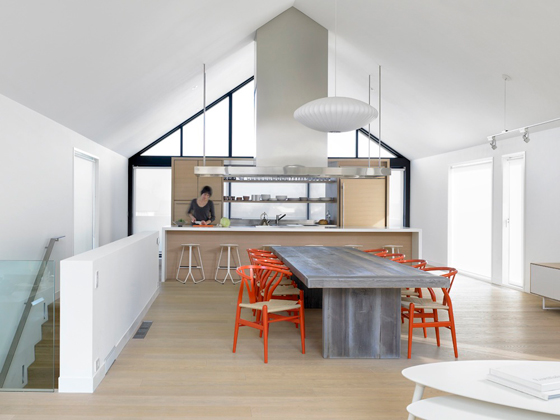
Maison Glissade in Collingwood, Ontario, lies on the edge of a ski piste. Atelier Kastelic Buffey's design took a cue from the country barn as a building type; photos Shai Gil
×The entrance to the house is formed by the 'mud room', a large anteroom akin to a ski cellar. Behind this area there are three simply designed bedrooms, two bathrooms and a larger parental bedroom. A staircase leads to the upper floor, which is divided into a kitchen, dining and living area and forms the core of the house. The glazed elevations at both ends highlight the open character of this upper floor, and enable those in the building to follow the action on the nearby ski slope.
...
In all these projects, the integration of exterior and interior space plays a decisive role. The natural setting is skilfully integrated with the interior by windows and openings that frame the landscape. At the same time, however, the basic function of the Alpine hut of protecting its occupants against the cold, rain and snow is not forgotten.
The fact that this protective function does not necessarily have to be expressed in the form of a rustic log cabin is demonstrated above all by those projects in South America, which decisively distance themselves from the European idea of 'home' and 'home comforts'. On the contrary, they display a preference influenced by modernism for natural, raw materials. In Europe, the native home of the mountain chalet, these rigorous new interpretations may, in turn, have provided the inspiration for a new approach to this traditional type of building as well as experimentation with new variations on the theme.
....

